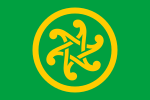Paul-Yves Pezron (20 January 1639, Hennebont, – 9 October 1706, Brie) was a seventeenth-century Cistercian brother from Brittany, best known for his 1703...
2 KB (195 words) - 12:46, 27 August 2024
to describe this language group by Edward Lhuyd in 1707, following Paul-Yves Pezron, who made the explicit link between the Celts described by classical...
66 KB (5,735 words) - 00:58, 9 August 2024
He published his work in 1707, shortly after translating a study by Paul-Yves Pezron on Breton. Grammars of European languages other than Latin and Classical...
41 KB (3,956 words) - 22:41, 28 July 2024
when these ideas were widely popularised; first by the Breton scholar Paul-Yves Pezron in his Antiquité de la Nation et de la langue celtes autrement appelez...
74 KB (8,771 words) - 22:32, 27 July 2024
family. Lhuyd also published an English translation of a study by Paul-Yves Pezron into Gaulish. In 1767 James Parsons published his study The Remains...
32 KB (3,518 words) - 18:17, 21 June 2024
Brittonic languages. Building on the earlier work of George Buchanan and Paul-Yves Pezron, he categorized these languages as a Celtic language family sharing...
54 KB (6,574 words) - 10:12, 12 June 2024
the work of the likes of John Davies (Mallwyd), Edward Lhuyd, and Paul-Yves Pezron and Gottfried Wilhelm Leibniz. She continued to research extensively...
5 KB (534 words) - 02:58, 22 April 2024
century. Lhuyd and others (notably the 17th century Breton chronologist Pezron) equated the Celts described by Greco-Roman writers with the pre-Roman peoples...
62 KB (6,557 words) - 11:20, 9 August 2024




